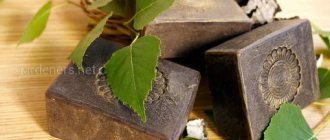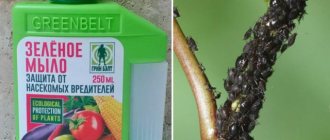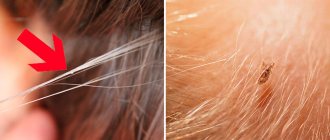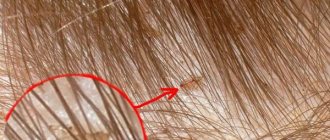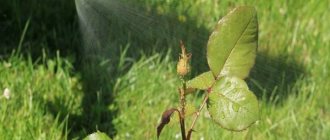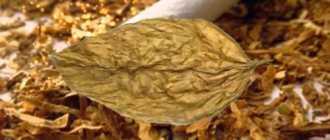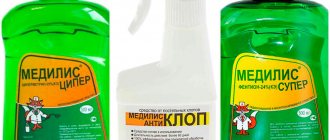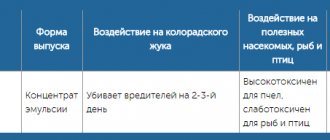Probably every gardener and gardener has had to deal with such a problem as aphids on the site. To combat this pest, soap has been actively used for many years. And although today there are various versions of it, tar remains unchanged. There are a large number of recipes for a solution for treating plants based on tar soap.
The choice of one or another option must be made taking into account which crop suffered from the invasion and how many aphids settled on the plant.
Pest Control
Tar soap, due to its specific aroma, repels pests well. To use the soap, you need to grate it using a regular grater. The shavings are used both in indoor floriculture and in the garden. If midges appear, then it should be poured in small quantities onto the soil. To treat large areas, a solution based on tar soap can be used. Need to:
- grind two pieces of soap on a coarse grater;
- pour two liters of warm liquid;
- stir until a homogeneous mixture is obtained.
The resulting composition can be bottled for storage. If the need arises, you need to dilute a liter of liquid soap with 5 liters of water, resulting in a concentrate being created. A liter of liquid is poured into a 10-liter watering can and diluted with 9 liters. water. The method allows you to eliminate:
- flies,
- codling moth,
- aphids,
- weevil,
- Colorado potato beetle and other pests.
It is not recommended to water crops at the flowering stage with a tar-based mixture, since beneficial insects may stop pollinating them.
Who does tar scare away?
As a repellent, tar in the garden and garden is most effective against objects of elimination that have a keen sense of smell and wholly or partially lead an underground lifestyle, because In the soil, the active ingredients of tar remain longer. These factors mutually reinforce each other. Based on this, the repellent effect of tar on different groups of pests is divided into 3 categories:
- Severe – lasts more than 30 days. As a rule, one treatment per season is enough for the objects of elimination to remove themselves from the site in all directions;
- Medium – lasts up to 30 days, but is stable;
- Mild – lasts less than 30 days. In cold weather it weakens or stops.
Tar drives away mole crickets, moles, voles and gypsy moths most strongly, see figure:
The latter does not live underground, but its males have an ultra-fine sense of smell: they find females by smell from kilometers away. The tar stench disrupts the search for mating partners, and the population in the surrounding area dies out. But, if you also have large, beautiful and harmless pinnate butterflies (for example, large night peacock eye - pear peacock eye, Artemis peacock eye, ocellated toothed one), then they too will disappear. You can also not expect visits from specialized pollinators such as hawkmoth butterflies after treating the area with tar. You can get rid of mole crickets with tar at once for the entire season, see for example. video:
Video: tar against mole crickets and mice
Medium tar drives away Colorado potato beetles, white butterflies (cabbage moths), codling moths, moths, phytophagous flies (onion flies, cruciferous flies), larvae of click beetles (wireworms), sawflies, other rodents, hares and slugs, see figure:
The use of tar against these pests is completely justified, because allows, if not to expel them completely, but to greatly reduce the dose of pesticides and the costs of them. How to use tar to make it easier to fight the Colorado potato beetle, see the story:
Video: processing potatoes with tar
Finally, tar weakly repels ants, elephant beetles and weevils, adult click beetles and bronze beetles, see next. rice. Fighting these pests with tar alone is unlikely to be successful. Ants - foragers and herders of aphids - may die from tar, but their loss for the anthill as a “superorganism” is, in general, no more sensitive than cutting hair or nails for us. It is possible to expel ants from a site with tar only if the anthill is outside its boundaries and measures are taken to combat aphids. Then the “superorganism” will redirect the foragers to another place, and force the shepherds to transfer the aphids there.
Ant protection
Tar soap is also useful for removing ants. The prepared composition can be poured into an anthill. Sometimes damaged bushes, leaves and stems are sprayed with it. Sometimes soda is additionally added to the solution, but when preparing such a solution you need to carefully monitor the dosage. Sodium carbonate is an aggressive substance.
Before preparation, the soap is crushed and 10 liters are poured. hot water. It remains to pour half a glass of baking soda and leave for 120 minutes. After this, the solution is filtered through 2-4 layers of gauze. The areas where ants live should be watered generously. If the nest is located underground, then before processing it must be dug out by removing the top soil. After some time, the ants will disappear and will no longer appear in this place.
Instead of soda, you can apply tobacco leaves to tar soap. You will need 200 g of them. First, pass them through a coffee grinder, pour them into a bucket, add hot pepper. Pour the mixture with 10 liters of water, leave for a day to infuse. When the time is up, add 40 g of tar soap.
How to choose
For any recipe that will be given in the article, you will need classic tar soap without various additives and impurities that improve the aroma. You can buy this composition in any store at low prices. In this case, you can not pay attention to the attractiveness of the packaging. First of all, to get rid of insects, we are interested in the composition of soap. Moreover, when preparing various solutions, it is necessary to use this soap only in the solid state.
Tar soap and aphid ash
After the end of the flowering period of currants and other berry crops, they can be treated against aphids with a solution of soap and ash. It is made from 0.5 kg of wood ash, 10 liters. water. Add 50 g of ground soap to this mixture. Some gardeners add a few cloves of finely chopped garlic. The solution is applied to the top of the bush where the pests are.
There is one more recipe. Mix 300 g of ash with 10 l. water and place on the stove. After the solution boils, reduce the heat and cook for 30 minutes. When the solution has cooled, all that remains is to add soap and stir it thoroughly. The product should be used immediately before use.
Plants are usually sprayed using a spray bottle. With its help, it is easier to make sure that the solution gets onto the back side of the foliage. Aphids are usually concentrated on it. For prevention, it is recommended to carry out treatment once a week. When identifying an aphid population, the procedure is carried out several times with an interval of 2-3 days. It is worth spraying not only damaged plants, but also neighboring plants, since there is a possibility that not all pests will die the first time. They may be looking for a new place for themselves. Manufacturers offer various means to protect plants from diseases and insects. Some problems can be easily dealt with with simple remedies. One of their representatives is tar soap. It is easy to use and the results last a long time. This is due to the fact that it contains birch tar. This is a natural and environmentally friendly product that has disinfecting and antiseptic properties.
Tobacco solution
Making a soap solution for aphids with the addition of tobacco is very simple:
- 200 g of dry leaves are ground into powder and added to a bucket of water;
- grind 3 pods of fresh hot pepper, combine with tobacco solution, leave for 24 hours;
- add 100 g of grated laundry soap, 3 tbsp. spoons of wood ash or cinnamon, mix everything thoroughly.
On a note!
Treatment of plants with soap with the addition of several active components provides high results and quick action.
Pest Control
Tar soap, due to its specific aroma, repels pests well. To use the soap, you need to grate it using a regular grater. The shavings are used both in indoor floriculture and in the garden. If midges appear, then it should be poured in small quantities onto the soil. To treat large areas, a solution based on tar soap can be used. Need to:
- grind two pieces of soap on a coarse grater;
- pour two liters of warm liquid;
- stir until a homogeneous mixture is obtained.
The resulting composition can be bottled for storage. If the need arises, you need to dilute a liter of liquid soap with 5 liters of water, resulting in a concentrate being created. A liter of liquid is poured into a 10-liter watering can and diluted with 9 liters. water. The method allows you to eliminate:
- flies,
- codling moth,
- aphids,
- weevil,
- Colorado potato beetle and other pests.
It is not recommended to water crops at the flowering stage with a tar-based mixture, since beneficial insects may stop pollinating them.
Moles
It is clear what to do with insect pests. But summer residents also have other garden enemies, for example, moles. With their active underground activity, they cause significant damage to the health and sometimes even the life of gardening plants.
The mole is an uninvited guest in any garden
To drive these uninvited guests away from the site, mix 1 cup of tar and 1/3 cup of vegetable oil and soak pieces of rags with this emulsion. After this, dig out all the molehills that you find on the site, put a fragrant rag in each hole and fill the holes with earth. After such “aromatherapy,” the moles will quickly leave the occupied territory.
Ant protection
Tar soap is also useful for removing ants. The prepared composition can be poured into an anthill. Sometimes damaged bushes, leaves and stems are sprayed with it. Sometimes soda is additionally added to the solution, but when preparing such a solution you need to carefully monitor the dosage. Sodium carbonate is an aggressive substance.
Before preparation, the soap is crushed and 10 liters are poured. hot water. It remains to pour half a glass of baking soda and leave for 120 minutes. After this, the solution is filtered through 2-4 layers of gauze. The areas where ants live should be watered generously. If the nest is located underground, then before processing it must be dug out by removing the top soil. After some time, the ants will disappear and will no longer appear in this place.
Instead of soda, you can apply tobacco leaves to tar soap. You will need 200 g of them. First, pass them through a coffee grinder, pour them into a bucket, add hot pepper. Pour the mixture with 10 liters of water, leave for a day to infuse. When the time is up, add 40 g of tar soap.
Soda solution
Soap and baking soda work wonders against aphids. The effect is noticeable by the end of the day if the treatment was carried out early in the morning. Initially, the required amount of the drug is determined. Prepare a soap solution (1/4 or 1/2 of a bar of soap per bucket is enough), add soda at the rate of 1 tbsp. spoon per 1 liter of water. You will need 10 spoons per bucket. Mix thoroughly.
Baking soda causes irritation and damages the skin; soap prevents insects from escaping. The pests will die quickly within 24 hours.
Tar soap and aphid ash
After the end of the flowering period of currants and other berry crops, they can be treated against aphids with a solution of soap and ash. It is made from 0.5 kg of wood ash, 10 liters. water. Add 50 g of ground soap to this mixture. Some gardeners add a few cloves of finely chopped garlic. The solution is applied to the top of the bush where the pests are.
There is one more recipe. Mix 300 g of ash with 10 l. water and place on the stove. After the solution boils, reduce the heat and cook for 30 minutes. When the solution has cooled, all that remains is to add soap and stir it thoroughly. The product should be used immediately before use.
Plants are usually sprayed using a spray bottle. With its help, it is easier to make sure that the solution gets onto the back side of the foliage. Aphids are usually concentrated on it. For prevention, it is recommended to carry out treatment once a week. When identifying an aphid population, the procedure is carried out several times with an interval of 2-3 days. It is worth spraying not only damaged plants, but also neighboring plants, since there is a possibility that not all pests will die the first time. They may be looking for a new place for themselves.
Reviews
- Alexander, 45 years old: “For many years I have been fighting aphids in my garden using a solution of ash and tar soap. I carry out several such treatments during the season. What I like about this method of fighting aphids is its environmental safety. Spraying can be done at any time as soon as pest damage has been noticed. In addition, the soap solution adheres well to the leaves, so even after rain there is no need to re-treat.”
- Anna, 47 years old: “I have a whole flower garden of roses at my dacha. But lately I started noticing aphids on them. I didn’t dare to use chemicals, as they could ruin my beauty. I decided to use a simple soap solution made from tar soap. I no longer used any auxiliary components. I carry out the treatment in the evening, when it is quiet and windless outside. I use a regular broom for this. After the first treatment, the number of insects is reduced, and my roses come to life again. And in order to completely overcome the pest, I carry out 3 such treatments with an interval of 7 days.”
Tar soap is a unique product that is in great demand not only in cosmetology, but is also a good helper in the garden to combat various pests. Thanks to its rich aroma, which aphids cannot stand, insects begin to leave the garden and the plants come to life. But after some time, the pests may return again, so it is necessary to carry out such activities from time to time.
This link will tell you how to treat plums against aphids.
About the effectiveness of the product
A forum with positive user reviews proves the effectiveness of birch tar. Sometimes, to obtain the best result, several treatments should be carried out, which should be remembered by summer residents and gardeners! This should be done in clear weather, since if there is an excess of ambient moisture, the effectiveness of the natural insecticide decreases.
After dissolving in water, tar does not work for a long time, so it should be used immediately after diluting and cooling the liquid. Birch resin must be used strictly according to folk recipes, otherwise it will not be possible to wait for the desired disappearance of aphids and ants that are in close contact with each other.
Which is better?
Moonshine tar is free, but it is the least effective and contains the greatest amount of harmful substances. Therefore, it is advisable to use purchased birch tar of varying degrees of purification in the vegetable garden (from left to right in the figure below).
Purified tar no longer looks like a black slurry, but a dark brown translucent substance. By the way, working mixtures from it remain homogeneous not for 15-20 minutes, but for more than an hour. The most expensive, but also the most effective substance is perfume. Perfume tar is used for aromatherapy and adding piquancy to odors. For both, the drug is used, of course, in microdoses.
Almost equivalent to perfume, but much cheaper than medical tar. Veterinary is not much cheaper than medical, but is only slightly more effective than moonshine. But tar soap, although it contains a ready-made adhesive, is not very effective as a pest repellent. There is very little tar in it, in a dose safe for humans, which almost does not repel pests.
Natural enemies
If we talk about natural conditions, then in the forest hedgehogs, frogs, lizards and other animals are not averse to feasting on goosebumps. It will not be possible to create such a zoo in vegetable gardens and orchards, and they will do more harm than good. Therefore, you have to rely on nature and luck, which will attract natural pest exterminators without damaging the garden.
Birds are not averse to eating goosebumps, they especially love larvae and will not bypass the queen. During the day you can often see a picture of a bird raking the soil and diligently looking for something; it is looking for these particular pests.
But you can’t count on their help, because with large concentrations of pests, more than one bird is needed, and the process of destroying anthills takes time, and we all know that birds don’t like to be neighbors with people, so their help will be minimal.
An antlion can be an ideal savior; this beetle is the most dangerous for pests and is capable of completely clearing an area of ants and other pests. If there is an opportunity to settle it on your site, this opportunity should not be missed.
Recommendations
Gardeners recommend starting preventive measures in early spring (especially in the southern regions), since already in April these insects wake up and begin to be active.
In addition to watering and pre-planting treatment, there are several other effective methods.
In between waterings, strips of fabric soaked in tar can protect the beds from pests. To do this, you need to cut the material into long strips of the required width, soak it well in a concentrated solution of birch tar, and then spread it between the beds.
Another good and effective way to combat onion flies is to prepare a special mulch, which will have triple benefits:
- pest protection;
- less intensive weed growth;
- retaining moisture in the soil for a longer time.
Mulch is prepared in a certain way.
- You need to take ten liters of water and dilute about five spoons of tar there. The solution must be quite concentrated for the effect to last longer.
- Then you need to take sawdust, which is best used as mulch in this case, and soak it well with the prepared solution.
- After this, the mulch is laid out on the beds.
After some time, the smell of tar will disappear anyway. Therefore, you can also water the plants throughout the entire season.
How to use birch tar, see below.
Precautionary measures
In accordance with the safety data sheet, birch tar is a non-explosive, non-flammable substance. If the instructions, recommendations for use and disposal of residues are followed, thermally hazardous decomposition products are not released.
General recommendations:
- carry out processing in special clothing, work shoes and gloves;
- in order not to cause a burn to the upper respiratory tract, be sure to wear a respirator or protective mask;
- when diluting mixtures, use special containers;
- after contact with the drug, thoroughly wash your hands and face, take a hot shower, change your underwear;
- after use, burn any remaining product (packaging, gloves, plastic bottle);
- In case of poisoning, allergic reaction, accidental ingestion, immediately call an ambulance; self-medication is dangerous.
